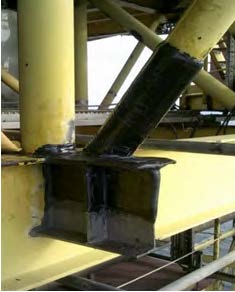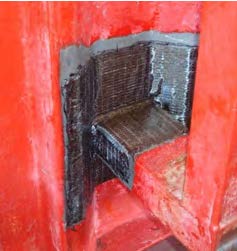The USA is a thriving market for ICR Group . In recent months we’ve doubled the size of our American business, and we have stregthened our team to help us capitalise on new opportunities in diverse market sectors.
As a provider of specialist maintenance, integrity, and inspection solutions, we have a range unique products that provide significant benefits customers in industries ranging from oil & gas oil & gas and renewables to defence, nuclear and telecoms.
Stemming from our focus on technological innovation – and founded on the principles of safety, reliability, and efficiency – our products serve to protect and maintain assets and critical infrastructure for customers around the world. One of the products that is gaining significant traction in the USA is Technowrap.
Technowrap™ is a versatile “Structural, Pipework and Pipeline repair and rehabilitation technology that offers a long-term alternative to steel replacement that requires minimal disruption to operations. Applied to live targeted areas, with no requirement for shutdown, Technowrap supports safe operations whilst delivering tangible cost savings and environmental benefits.
One of the key benefits of the technology is it’s versatility. Our bespoke engineered repair systems use either glass or carbon fibre stitched cloths, combined with two-part epoxy resins Technowrap is suitable for use on pipework and piping components, valves, and flanges as well as repairs in the Splashzone as well as structural components; including decks, roofs, beams, caissons and risers, blast walls, tanks and vessels.
Technowrap™ is internationally recognised and all engineering is bespoke and completed in-house, in accordance with the latest issues of ISO 24817 and ASME PCC-2, offering a repair life of up to 20 years dependant on design conditions.
Some of the key
- With Technowrap’s increasing popularity among US customers, there are numerous examples that attest to this, foir example;.We provided an engineered composite repair on a large methanol drip pan on an offshore platform in the Gulf of Mexico – with a 10-year design life –
- Technowrap was used repairto reinstate the integrity of two pressure vessels for a major operator in the Texas Eagle Ford Basin. This solution has a 20-year design life as well as long-term corrosion protection.
- We partnered with a local specialist provider to refurbish a corrosion-hit main deck on a platform offshore Trinidad & Tobago. The work, for a global operator, constituted a cold-work solution as the platform was online.
- Technowrap was used to reinstated a production chemical injection skip pan on an asset in the Gulf of Mexico, for a global major operator. Again, this was engineered with a 10-year design life
- Several areas of a logging support deck plate on a global supermajor’s platform in the Gulf of Mexico were repaired using a Technowrap application.
Each of these projects posed unique challenges, yet they all shared a common priority: implementing a robust repair solution that would restore confidence in our customers regarding the integrity of their infrastructure.We’re continuing to grow our reputation in the States – and indeed internationally – as a specialist partner looking to identify and safely deliver the optimum solution.
I’m proud of what we’ve achieved in the US to date, but we’re only getting started. We plan to grow our profile, grow our business, and grow our track record of front-line success.
Houston-based Phil Paterson is ICR Group’s Business Development Director. ICR Group specializes in asset integrity, maintenance and inspection across various sectors, with a strong presence in the US and the Gulf of Mexico.
 Phil Paterson
Phil Paterson
Business Development Director
Client Challenge
Structural components (including I-beams, CHS sections, roofs, panels, members, struts) can suffer both corrosion resulting in material loss. This material loss can be severe such that the component is no longer fit for service.
What We Did
The design challenge for a structural component repair is to ensure sufficient strength or stiffness within the composite repair to withstand the applied loads, either in-plane or bending and also whether those loads are tensile or compressive. A design methodology for the repair of structural components has been developed by ICR TechnowrapTM (based on ISO 24817) that ensures both repair strength and stiffness. It is possible to design the repair either with or without allowance for the remaining strength or stiffness of the structural component.
Application
The installation of a composite repair on a structural component is comparable to in procedure to that of pipework. The main difference is the mean of compression used during curing of the repair.
Results
The repairs have either been designed to withstand the applied loads or return the component back to its original strength with a warranted design lifetime from between 5 and 20 years.


Introduction
As the energy infrastructure landscape in the United States undergoes transformation, the demand for innovative solutions that enhance efficiency, safety, and regulatory compliance has never been more pronounced. Quickflange weldless connectors offer substantial advantages over traditional welding and replacement methods. This thought leadership piece aims to highlight the benefits of Quickflange weldless connectors in the US market, emphasising regulatory approval and the transformative impact on pressure systems integrity and maintenance.
Regulatory Approval
The USA’s stringent regulatory environment places a premium on safety in all industrial operations, and Quickflange has successfully navigated this. With case-by-case installation approvals from regulatory bodies including Bureau of Safety and Environmental Enforcement (BSEE), attesting to its use as a permanent repair method, these connectors have become a trusted choice for maintenance projects. This regulatory endorsement for connectors up to 14” NPS, provides confidence to operators, ensuring that they are adopting solutions aligned with the highest safety standards.
Mitigating Risks
The inherently safer nature of Quickflange aligns seamlessly with the risk mitigation priorities outlined by regulatory authorities. By eliminating the need for hot work and reducing the potential for accidents associated with traditional welding, these connectors contribute to a safer working environment. This not only safeguards personnel but also protects the integrity of the surrounding infrastructure.
Accelerating Project Timelines
In a sector where project timelines are critical, Quickflange stands out by streamlining installation and maintenance processes. The compact design of these connectors allows for rapid installation, significantly reducing downtime. With regulatory approval validating its reliability, operators can confidently implement the connectors to accelerate project timelines whilst dramatically improving the safety aspect, without compromising on the quality requirements.
Cost-Effective Regulatory Compliance
Quickflange not only fulfils regulatory standards but also provides a cost-effective alternative to traditional welding. The reduced downtime, minimised risk of accidents, and streamlined compliance processes contribute to long-term cost savings. Further to this the reduced labour requirements and costs associated with these connectors contribute to an overall more economical solution, thus allowing operators to allocate resources more strategically, optimising their budget for sustained operations.
Environmental Benefits
Quickflange also offers several environmental benefits compared to traditional welding methods, contributing to a more sustainable approach to maintenance. These benefits include reduced emissions, minimised waste generation, enhanced environmental compliance, and long-term sustainability. These advantages align with the growing global emphasis on sustainable practices.
Conclusion
Quickflange has not only earned its place as an innovative technology but has successfully navigated the regulatory landscape in the USA. As the energy industry continues to evolve, these connectors offer a safer, more efficient, and economically viable alternative to traditional welding methods. By aligning with regulatory standards, operators can not only meet compliance requirements but also pave the way for a future where pressure systems integrity is synonymous with innovation and safety.

